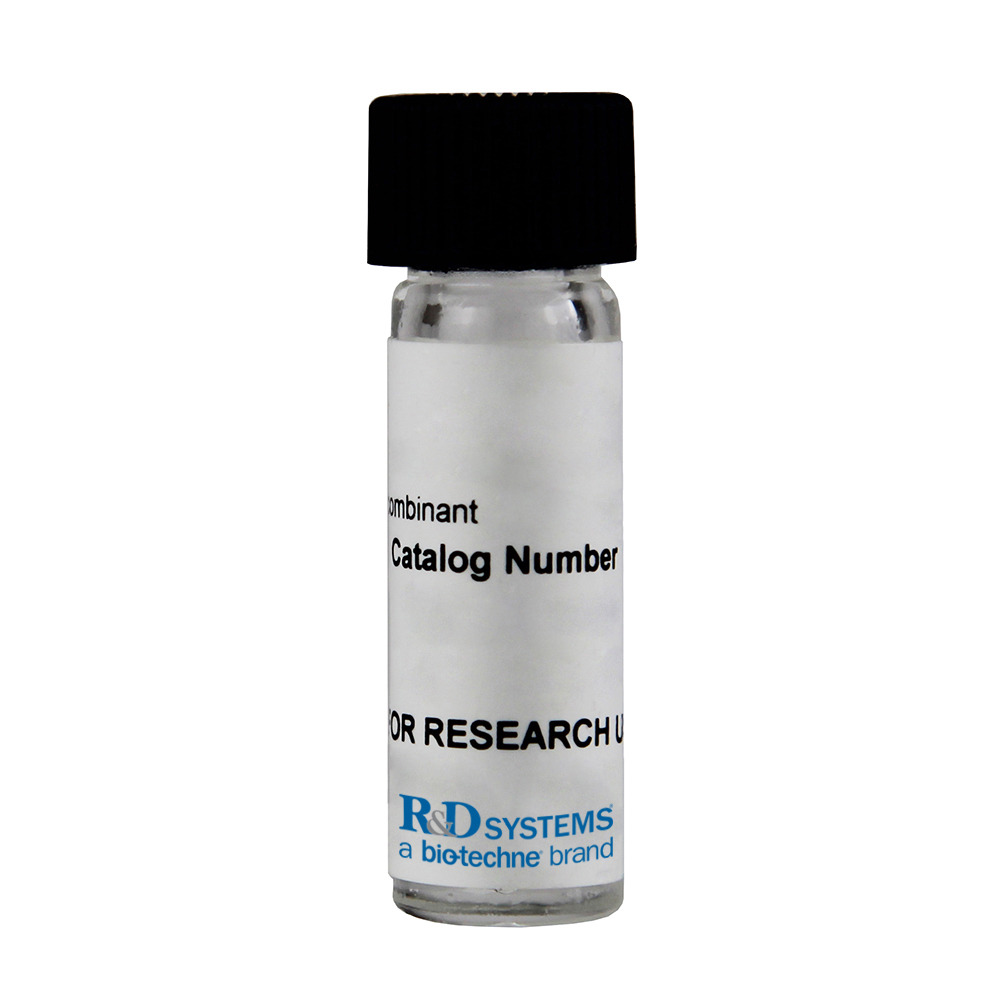Recombinant Human ERO1L alpha Protein, CF Summary
Product Specifications
Glu24-His468, with a C-terminal 6-His tag
Analysis
Product Datasheets
Carrier Free
CF stands for Carrier Free (CF). We typically add Bovine Serum Albumin (BSA) as a carrier protein to our recombinant proteins. Adding a carrier protein enhances protein stability, increases shelf-life, and allows the recombinant protein to be stored at a more dilute concentration. The carrier free version does not contain BSA.
In general, we advise purchasing the recombinant protein with BSA for use in cell or tissue culture, or as an ELISA standard. In contrast, the carrier free protein is recommended for applications, in which the presence of BSA could interfere.
9855-EO
| Formulation | Supplied as a 0.2 μm filtered solution in Tris, NaCl and TCEP. |
| Shipping | The product is shipped with dry ice or equivalent. Upon receipt, store it immediately at the temperature recommended below. |
| Stability & Storage: | Use a manual defrost freezer and avoid repeated freeze-thaw cycles.
|
Assay Procedure
- Assay Buffer: 50 mM NaH2PO4, pH 7.5
- Recombinant human ERO1L (rhERO1L) (Catalog # 9855-EO)
- Coupling Enzyme: Horseradish Peroxidase (HRP) (250-330 U/mg) (Sigma, Catalog # P8375), 250 Units/mL stock in 0.1 M Sodium Phosphate, pH 8.0
- Substrate Component 1: Dithiothreitol (DTT) (VWR, Catalog # VWRV0281), 1 M stock in deionized water
- Substrate Component 2: Amplex® Ultra Red (AUR) (Invitrogen, Catalog # A36006), 10 mM stock in DMSO
- F16 Black Maxisorp Plate (Nunc, Catalog # 475515)
- Fluorescent Plate Reader (Model: SpectraMax Gemini EM by Molecular Devices) or equivalent
- Dilute rhERO1L to 80 ng/µL in Assay Buffer.
- Dilute DTT to 20 mM in deionized water, and then dilute to 600 µM in Assay Buffer immediately prior to use.
- In a plate load 25 µL of 80 ng/µL rhERO1L, and start the reaction by adding 25 µL of 600 µM DTT. Include a Substrate Blank containing 25 µL of Assay Buffer and 25 µL of 600 µM DTT.
- Cover plate and incubate for 20 minutes at room temperature.
- Prepare Substrate Mixture containing 2 U/mL HRP and 100 µM AUR in Assay Buffer.
- Add 50 µL of Substrate Mixture to all wells.
- Read at excitation and emission wavelengths of 544 nm and 590 nm (top read), respectively, in endpoint mode. Note: A cutoff must be set at a wavelength of 570 nm.
- Calculate specific activity:
Specific Activity (pmol/min/µg) = | Adjusted Fluorescence* (RFU) x Conversion Factor** (pmol/RFU) |
| Incubation time (min) x amount of enzyme (µg) |
*Adjusted for Substrate Blank.
**Derived using calibration standard prepared by incubating 50 µM AUR, 1 unit/mL HRP, 150 µM DTT, and a curve of Hydrogen Peroxide (Sigma, Catalog # H1009) in Assay Buffer. Use this oxidized AUR curve to determine the conversion factor.
- rhERO1L: 2.0 µg
- DTT: 150 µM
- HRP: 1 unit/mL
- AUR: 50 µM
Reconstitution Calculator
Background: ERO1L alpha
Endoplasmic reticulum oxidoreductase 1-like protein alpha (ERO1L alpha) is an FAD-dependent protein disulfide oxidase. Disulfide bond formation in mammalian endoplasmic reticulum relies on the combined activity of ERO1L and protein disulfide isomerase (PDI), the enzyme responsible for catalyzing protein disulfide formation. During formation of disulfide bonds, ERO1L concurrently produces hydrogen peroxide making it a source of reactive oxygen species production (1, 2). There are two mammalian homologues of ERO1 that share 65% sequence identity (3); ERO1L alpha is more widely expressed while ERO1L beta is present in select tissues (4). Both homologues contain two essential conserved cysteine triads. The N-terminal triad is involved in interaction with PDI whereas the C-terminal triad forms an active site near FAD (4). Both homologues are regulated by the formation of disulfide bonds within the active site cysteines but whereas ERO1L beta is loosely regulated (5), enzyme activity of ERO1L alpha is tightly controlled (6-8). ERO1L alpha has been shown to be critical in hepatic stellate cell proliferation making it a potential target for managing liver fibrosis (9). ERO1L alpha knockdown inhibits cell proliferation, migration, invasion and chemoresistance (10) while overexpression promotes tumor growth and angiogenesis (11). ERO1L alpha is overexpressed in various types of tumors including breast, gastric, and colon cancer where its up-regulation correlates to a poor prognosis (10-13). ERO1L alpha has been proposed to be a clinically promising therapeutic target for ERO1L expressed cancers (10-12).
- Gross, E. et al. (2006) Proc. Natl. Acad. Sci. USA 103:299.
- Zito, E. (2015) Free Radic. Biol. Med. 83:299.
- Pagani, M. et al. (2000) J. Biol. Chem. 275:23685.
- Inaba, K. et al. (2010) EMBO J. 29:3330.
- Wang, L. et al. (2011) Biochem. J. 434:113.
- Baker, K.M. et al. (2008) EMBO J. 27:2988.
- Appenzeller-Herzog, C. et. al. (2008) EMBO J. 27:2977.
- Kanemura, S. et al. (2016) J. Biol. Chem. 291:23952.
- Fujii, M. et al. (2017) J. Biol. Chem. 292:15649.
- Seol, S.Y. et al. (2016) Cancer Res. Treat. 48:1196.
- Tanaka, T. et al. (2016) Br. J. Cancer 114:1227.
- Zhou, B. et al. (2017) Exp. Ther. Med. 14:2298.
- Kukita, K. et al. (2015) J. Immunol. 194:4988.
FAQs
No product specific FAQs exist for this product, however you may
View all Proteins and Enzyme FAQsReviews for Recombinant Human ERO1L alpha Protein, CF
There are currently no reviews for this product. Be the first to review Recombinant Human ERO1L alpha Protein, CF and earn rewards!
Have you used Recombinant Human ERO1L alpha Protein, CF?
Submit a review and receive an Amazon gift card.
$25/€18/£15/$25CAN/¥75 Yuan/¥2500 Yen for a review with an image
$10/€7/£6/$10 CAD/¥70 Yuan/¥1110 Yen for a review without an image

